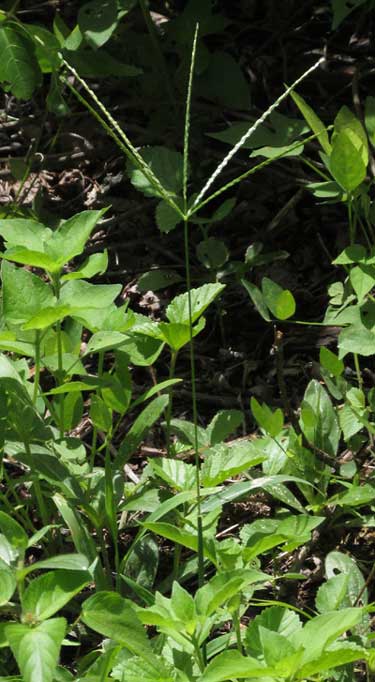Excerpts from Jim Conrad's
Naturalist Newsletter
from the August 14, 2016 Newsletter issued from Hacienda Chichen Resort beside Chichén Itzá Ruins; limestone bedrock; elevation ~39m (~128ft), N20.675°, W88.569°; central Yucatán state, MÉXICO
TROPICAL CRABGRASS
In thin soil atop limestone bedrock, along a weedy path through the Hacienda's woods, a cluster of grass flowers caught my attention looking exactly like a flowering head of the North's Common Crabgrass, Digitaria sanguinalis. Below, you can see what I mean:

Crabgrass arrays its spikelets in a few narrow, spike-like racemes radiating from the top of a stem, like the spreading-out toes of a chicken foot. Such flowering heads, or inflorescences, are said to be "digitately" arranged, and other common grasses that do it include Bermuda Grass and Goose Grass. In these grasses, all the spikelets arise from one side of a flat inflorescence-branch, or rachilla. Below, you can see a top view of one of this grass's gracefully curving, ribbon-like rachillas, with spikelets peeping out from beneath it:

The undersides of the same rachillas, showing the spikelets, are seen below:

Any close look at a grass requires a glance at the ligules formed where the grass blade meets and wraps its sheath around the stem. Our path-side grass's is shown to be very different from the line of hairs seen on many grasses. Instead, it's a papery or "membranous" one, as shown below:

All these features seem to me just like those of the North's Crabgrass. However, that species, Digitaria sanguinalis, isn't listed among the several Digitaria species found in the Yucatan Peninsula. Of the ones listed, ours matches DIGITARIA CILIARIS, sometimes known as Tropical Crabgrass.
The Digitaria ciliaris page of the online Manual of the Alien Plants of Belgium states that the species "... appears to be the (sub-) tropical counterpart of the more temperate D. sanguinalis. Typical plants of both are easily distinguished ... but more or less intermediate forms regularly occur and the specific boundaries, if any, remain unclear." It's surprising that Tropical Crabgrass occurs in chilly, rainy little Belgium, but it's explained that the species' seeds regularly turn up in commercial birdseed mixtures, including pheasant feed, sown there by gamekeepers.
The online Flora of China further explains why our Tropical Crabgrass might be so similar to the North's common Crabgrass with the remark that Digitaria ciliaris "...lies at the center of a complex of similar and somewhat intergrading, weedy species including D. bicornis, D. cruciata, D. henryi, D. radicosa, D. sanguinalis, and D. setigera. Occasionally intermediate specimens will be encountered that are difficult to place." Notice North America's weedy Digitaria sanguinalis in that list.
The Flora of China also tells us that about 250 crabgrass species -- members of the genus Digitaria -- are recognized worldwide. When you browse among the species you see that such neatly arranged chicken-foot flowering heads are not the rule for the whole genus. Many species distribute their rachillas along the stem, and some even array their spikelets not in racemes but in branching panicles.
Whatever the crabgrass along our trails here at the Hacienda end up being named, we can confidently say that down here in the Yucatan we have crabgrass, and it behaves and looks pretty much like the North's.